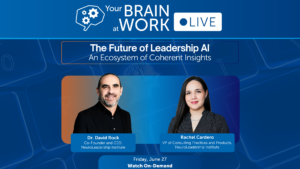The beloved author H.P. Lovecraft has been famously quoted as saying that “the oldest and strongest emotion of mankind is fear, and the oldest and strongest kind of fear is fear of the unknown.”
Lovecraft was no neuroscientist or business expert, but in this era of constant change, his sentiment rings true. Organizations face technological advances like never before, creating an ever-growing gap between existing and required skills.
At NLI, we believe even the most fearful leader can take solace in the science of perspective-taking, insight, and effective execution, in order to lead a transformation in their organization.
Here are three brain-based strategies all leaders can employ.
[action hash=”1c967ecd-f614-4b3d-a6f1-a14c6ec523bc”]
1) Use SCARF® to practice perspective-taking
Taking others’ perspectives offers many benefits, including seeing new possibilities with clients, colleagues, and even competitors. Perspective-taking facilitates social understanding and increases willingness to engage with others, build relationships, increases perceived leadership capability, and decreases stereotyping.
Perspective-taking hinges on three processes: understanding that others possess mental states, realizing those mental states are not identical to our own, and overcoming the self-focused bias of our own perspective.
Leaders can use the SCARF® Model — a way of grouping five domains of social threat and reward — to facilitate understanding of others’ motivation and social behavior. Specifically, they should explicitly ask for others’ perspectives, consciously take the perspective of those they seek to understand, and purposefully set aside time to practice.
2) Accelerate breakthroughs by creating the conditions for insight
Innovation requires creative thinking, which neuroscience research suggests often derives from moments of insight.
Research also shows that there is a reliable series of events that precede emergence of an insight — meaning that it’s not random; it follows a process. Threat and noise reduce the likelihood of insight generation, while a positive mood and relaxed state increase the chance of insight.
Leaders can approach team processes with insight in mind by noticing when people tend to have the deepest insights and creating those conditions in daily processes. For example, leaving mornings — when people tend to have the most insights — free for private, quiet work. And allow people to have a few quiet minutes to reflect during a meeting rather than all working aloud.
3) Create extreme clarity for faster execution
Uncertainty creates threat, flatlines creativity, impairs decision making, and ultimately diminishes productivity. When people feel threatened, their instinct is to be as careful as possible, often to the point of excess. For instance, role uncertainty breeds indecision and a pathological need for consensus to ensure that everyone is in agreement, which impedes swift progress.
To mitigate threat and promote efficiency, leaders should create extreme clarity and set clear expectations in the areas that matter most. These include roles, process, and determining what “good” looks like. Creating extreme clarity in all five SCARFⓇ domains generates a sense of perceived control, which is fundamentally rewarding. Individuals and teams are more motivated to work together and accomplish goals with alacrity through transformation.
Indeed, approaching transformation with the right strategies is like folding a paper airplane. Done right, you can make that flat piece of paper soar.
[action hash=”1c967ecd-f614-4b3d-a6f1-a14c6ec523bc”]






